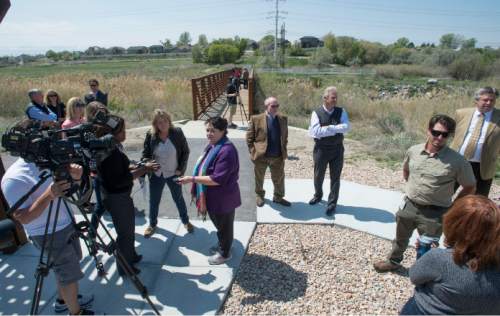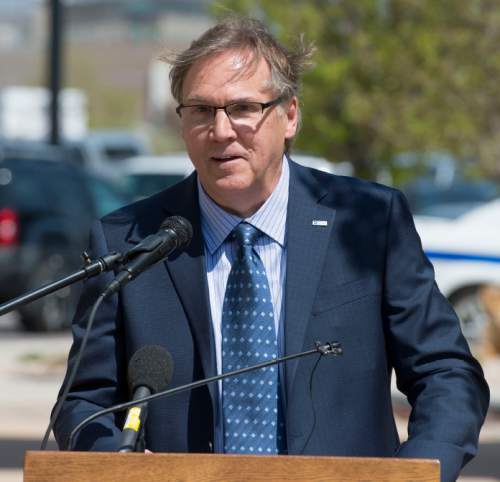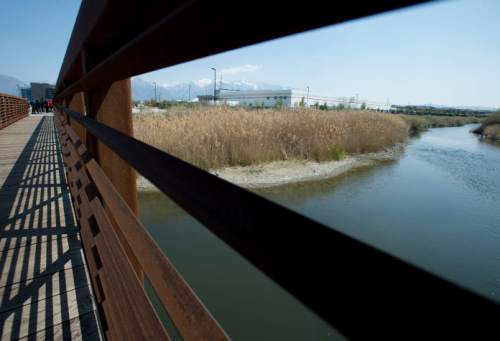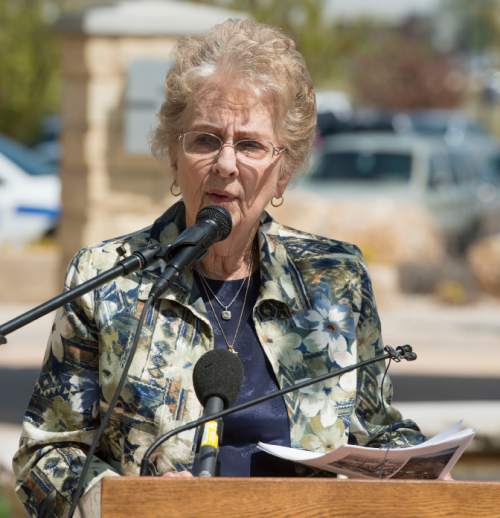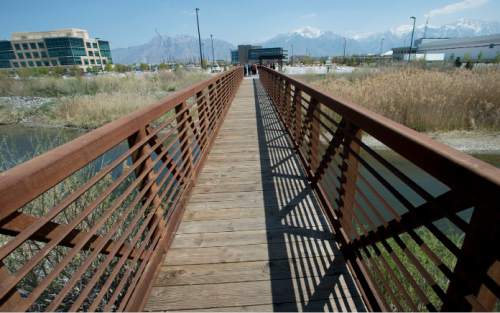This is an archived article that was published on sltrib.com in 2015, and information in the article may be outdated. It is provided only for personal research purposes and may not be reprinted.
Midvale • When Mayor JoAnn Seghini was elected to the Midvale City Council in 1986, the city had just learned it had two Superfund sites.
The former industrial areas were so contaminated, experts said, it would take 81 years to make them fit for human use.
But this month — about 50 years sooner than anticipated — the U.S. Environmental Protection Agency officially removed the Midvale slag site from the Superfund list, closing the loop on one of Utah's toughest industrial cleanups.
"Midvale's motto is 'In the Middle of Everything,' " Seghini said Monday at the rehabilitated site, now an office park. "Back in the day, we were in the middle of everything — when everything was railroads and mining."
In those days, mining took a big toll on the environment — not just on the land where ore was pulled from the ground, but also where valuable metals were separated out. The waste, known as slag, is the chief culprit in many of the nation's 1,300 Superfund sites.
The historic smelting center known as Bingham Junction, at the very heart of the Salt Lake Valley, had been home to five smelters before operations were shuttered in 1958.
Companies abandoned mountains of slag beside the Jordan River, whose channeled banks were sloughing into the water, contaminated with arsenic, lead and other heavy metals leaching from the waste.
"The Love Canal — we all remember that," Seghini said, referring to the New York catastrophe that prompted passage of the Superfund rules in 1980. "We are the Love Canal in Utah. How do you get out of that reputation and do something that will make a difference?"
Midvale leaders' answer was the thriving mixed-used development where local, county, state and federal officials gathered Monday to celebrate what the Superfund program can accomplish.
The new Bingham Junction, which combines residential, retail and office space around a TRAX stop, occupies the 466-acre site on the Jordan's east bank around 7200 South.
"This emphasizes what role environmental regulations and protection play," said Amanda Smith, executive director of the Utah Department of Environmental Quality. "We are ensuring the land we live on and the resources we use are being protected for future generations.
"This site exemplifies [not only] how difficult and long it takes," Smith added, "but how rewarding it is to return the land to viable economic uses."
Some 2,000 people live at Bingham Junction and 800 work there. And more office buildings are going up.
The tax base of the new neighborhood now exceeds $300 million, up from about $4 million in 2004, according to EPA.
Monday's event marked a notable departure from the usual rancor Utah officials express for EPA's involvement in the state's environmental affairs. The Midvale project is now held out as an example of how to do Superfund projects right.
"Who would have thought we would have this land redeveloped and in such a central area?" said Republican Sen. Brian Shiozawa, whose district covers Midvale.
By contrast, the adjacent Sharon Steel Superfund site immediately to the south was capped in such a way that prevented re-use. Tensions over that project, completed in 1999, prompted city officials to take a more active role in the slag site cleanup to ensure the strategically located land could be put back to use.
Much of the $40 million cleanup cost was covered by settlements with the responsible companies and the interest those payments earned. Federal tax dollars made up the rest.
To remediate the site, crews stabilized the banks along 7,000 feet of the river and reseeded them with native vegetation.
The most contaminated soil was hauled away and the rest was stabilized to keep its toxic contents from migrating, according to Fran Costanzi, a Superfund redevelopment coordinator.
Ground and surface water will continue to be monitored.
Regional EPA director Shaun McGrath presented Seghini with an achievement award honoring her city for excellence in site re-use.
"Removing the Midvale slag site from EPA's Superfund list is an example of the dramatic transformations that can happen when the Superfund program meets a strong and engaged community committed to redevelopment," McGrath said. "The quality of life and the economic value of Bingham Junction represents a stark contrast with the contaminated conditions we confronted in the 1980s.
"This transformation didn't happen by accident. It was the result of our ability to work together."





